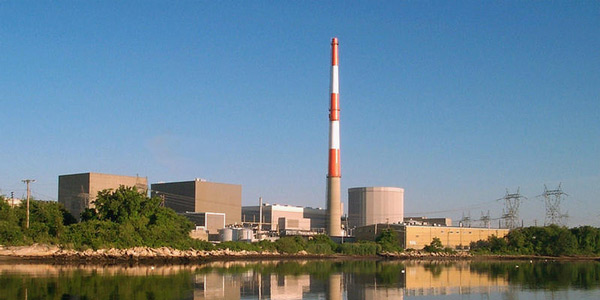By Rich Heidorn Jr.
Dominion Energy’s bid to win state subsidies for its Millstone nuclear plant took a hit Thursday as consultants hired by Connecticut said the plant is likely to remain profitable through 2035 even under low natural gas prices.
The report by Levitan & Associates concludes “there is no ‘missing money’ required to ensure Millstone’s financial viability through the existing term of Millstone’s Unit 2 operating license” in 2035.
The report projects that in 2022 the plant will earn after-tax net cash flow of $100 million under a low gas price/high operating cost scenario to more than $200 million under the reference case that assumes “business-as-usual” conditions.
“Under the reference case, the present value of Millstone’s after-tax cash flows [through 2035] is about $2.4 billion. This number is reasonably representative of Millstone’s enterprise value. Under the low gas price case, with all costs increased by 10%, the present value is $1.3 billion,” the consultants wrote. “However improbable the array of market and operating assumptions underlying the low gas price case with all costs increased by 10% may be, the associated enterprise value of $1.3 billion represents a conceivable ‘worst case’ for testing Millstone’s financial viability.”
The consultants added a caveat to their analysis, saying that if Dominion were required to replace its existing system with cooling towers as part of its National Pollutant Discharge Elimination System permit renewal, “it is likely that cash flow from energy and capacity sales would be insufficient to rationalize the investment.”
“We are still reviewing the report and don’t have a comment at this time,” Dominion spokesman Ken Holt said Thursday evening.
Connecticut Gov. Dannel Malloy ordered state regulators in July to assess the economic viability of the plant and determine whether the state should provide it financial support. Malloy’s executive order also directed the state Department of Energy and Environmental Protection (DEEP) and the Public Utilities Regulatory Authority (PURA) to assess the role of large-scale hydropower, demand-reduction measures, energy storage and emissions-free renewable energy in helping Connecticut meet its ambitious targets to cut its carbon output. (See CT Gov Orders Financial Analysis of Millstone Plant.)
DEEP and PURA released the Levitan study yesterday along with a draft report summarizing its conclusions and a request for comments on it, which are due Jan. 8. There will be a public hearing on the report Dec. 19 at Waterford High School.
PURA Chair Katie Dykes and DEEP Commissioner Robert Klee said during a press conference Thursday that the agencies will file a final report with their recommendations by Malloy’s Feb. 1, 2018, deadline.
Dykes said the regulators’ draft report contains no conclusion. “This report is laying out the dots,” she said. “It’s not necessarily connecting the dots.”
The regulators’ draft report noted “significant inherent difficulties” in evaluating the financial viability of a nuclear plant such as Millstone in a restructured market. “Merchant generators’ financial goals may exceed the regulated rate of return earned by cost-of-service generators, given merchant generators’ exposure to the risks of low energy prices, unplanned outages, and other costs that a regulated generator can recover from electric ratepayers,” the regulators said.
“Such is the challenge in assessing the financial viability of Millstone, and the advisability of mechanisms that would shift some of the risk of energy price volatility to the ratepayers of Connecticut. Despite DEEP and PURA’s specific data requests, Dominion only very recently provided a limited, two-page, high-level document with forward-looking financial projections. The document lacked the standard documentation supporting the projections concerning its actual financial condition. Thus, [Levitan] was limited to modeling Millstone’s financial viability using the best publicly available information.”
Levitan’s conclusions were consistent with findings of a study funded by subsidy opponents, including Calpine and Dynegy, which Dominion rejected as “loaded with gross assumptions and preposterous claims, with no real data.” Dominion, which purchased the 2,111-MW facility in 2001 for $1.28 billion, has said Millstone is more expensive to operate than other two-unit nuclear plants because its two units are of different designs. (See Millstone No Dead Weight for Dominion, Says Opponents’ Study.)
Levitan said its report was based on simulations modeling the New England wholesale energy market under several scenarios covering natural gas prices, expanded clean energy deployment and generation entry and retirements.
The consultants said they constructed a worst-case scenario increasing their proxy operating costs by 10%.
Because Dominion indicated last March that the plant will compete in ISO-NE’s Forward Capacity Auction next year, the company expects it to continue operations into at least 2022. Thus, the financial analysis considered only the period between 2022 and 2035, when the license for Millstone Unit 2 expires.
Malloy issued the executive order after Connecticut legislators failed to pass a bill sought by Dominion to boost the plant’s revenues.
Some subsidy supporters have said the loss of the plant would jeopardize the state’s ability to comply with the Global Warming Solutions Act of 2008, which mandates cutting greenhouse gas emissions to 10% below 1990 levels by 2020, and to 80% below 2001 levels by 2050.
Millstone supplies the equivalent of half of Connecticut’s electricity, but Dykes said the state is “long generation.”




